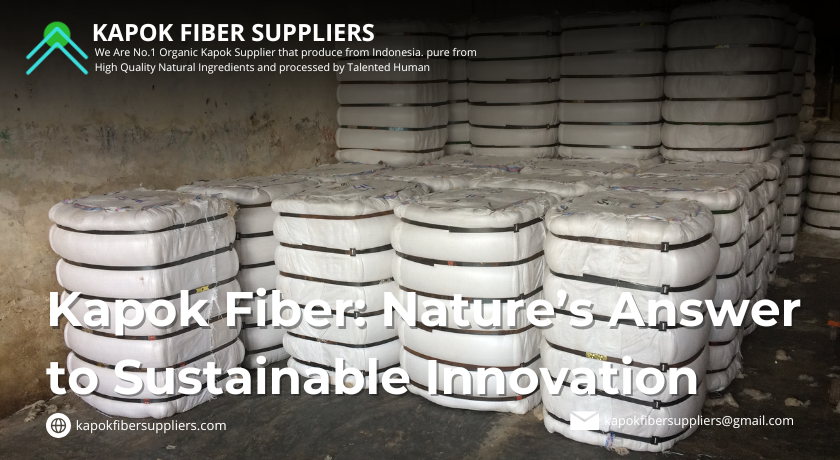
- What Makes Kapok Fiber Unique?
- 1. A Truly Circular Material
- 2. Comfort Without Compromise
- 3. Fighting Plastic and Foam Waste
- 4. Supporting Communities and the Planet
- Industries Embracing Kapok Fiber
- Conclusion: Kapok as a Symbol of Responsible Luxury
- What is kapok fiber?
- Why is kapok considered a sustainable material?
As industries around the world shift toward greener alternatives, one material is quietly redefining the future of comfort, performance, and sustainability: kapok fiber. Lightweight, biodegradable, and chemical-free, kapok is more than just a natural fill it’s a breakthrough solution for brands seeking both innovation and responsibility.
What Makes Kapok Fiber Unique?
Kapok is derived from the seed pods of the Ceiba pentandra tree, native to tropical regions. Unlike conventional crops, kapok grows naturally without the need for pesticides or intensive irrigation. Its silky, hollow fibers are eight times lighter than cotton and naturally water-resistant, making them ideal for multiple applications.
1. A Truly Circular Material
Kapok embodies the principles of a circular economy. Every part of the pod can be used:
- Fiber → for bedding, furniture, fashion insulation, and packaging.
- Seeds → for non-edible oil with applications in paint, biofuel, and soap.
- Shells → as compost or bio-based fillers.
This means kapok generates zero waste from harvest to end-of-life a critical advantage over synthetic materials that contribute to landfill and ocean pollution.
2. Comfort Without Compromise
For brands, switching to sustainable materials often means compromising on quality. With kapok, the opposite is true. Its fibers are:
- Naturally hypoallergenic, resisting mites and mold.
- Light yet insulating, perfect for outdoor apparel and luxury bedding.
- Eco-luxurious, offering a premium feel comparable to down or foam without the ethical or environmental issues.
This makes kapok a natural fit for eco-conscious bedding, fashion, and lifestyle brands that prioritize comfort and ethics equally.
3. Fighting Plastic and Foam Waste
The biggest advantage of kapok lies in what it replaces. Polyester, memory foam, and synthetic fills dominate today’s market but bring long-lasting pollution. Kapok provides a biodegradable, toxin-free alternative that completely eliminates the risk of microplastics entering waterways or food chains.
For industries under pressure to reduce plastic dependency, kapok is a clear and future-ready solution.
4. Supporting Communities and the Planet
Choosing kapok is not just a business decision it’s an investment in people and ecosystems. Harvesting kapok supports rural farming communities, particularly in Indonesia and Southeast Asia, where the fiber has been cultivated for generations. By partnering with ethical suppliers, brands can contribute to:
- Fair-trade opportunities
- Carbon footprint reduction
- Biodiversity preservation
This story of empowerment and sustainability also becomes a powerful message for modern consumers who demand transparency from brands.
Industries Embracing Kapok Fiber
Kapok is finding its place across diverse sectors:
- Home & Bedding → Pillows, duvets, mattresses.
- Furniture → Cushions, sofas, beanbags.
- Fashion → Outerwear insulation, eco-friendly accessories.
- Automotive → Lightweight padding.
- Packaging → Biodegradable protective fill.
This adaptability positions kapok as one of the most versatile natural fibers of the future.
Conclusion: Kapok as a Symbol of Responsible Luxury
Kapok fiber is more than a raw material it’s a statement of values. In a world demanding sustainable progress, kapok gives brands the rare ability to deliver luxury, comfort, and performance while staying true to eco-friendly principles.
For companies aiming to future-proof their products and reputation, kapok is not just an alternative it’s the answer.
📌 Trusted Kapok Supplier
If you’re looking for a reliable kapok fiber supplier with over 15 years of export experience:
CV. Media Mitra Indonesia
📍 JL. Ir. Soekarno No. 122, Kota Batu, Jawa Timur, Indonesia
📧 kapokfibersuppliers@gmail.com | 📞 +62 859-3313-3244
🌐 kapokfibersuppliers.com | kapokfibre.com
FAQ
What is kapok fiber?
Kapok fiber is a natural, silky-soft material harvested from the seed pods of the Ceiba pentandra tree. Known for its lightweight and buoyant properties, it has been traditionally used in pillows, mattresses, and life vests.
Why is kapok considered a sustainable material?
Kapok grows wild without the need for irrigation, pesticides, or fertilizers, making it one of the most environmentally respectful fibers. The harvesting process involves collecting the fiber from naturally fallen seed pods, ensuring that the trees remain unharmed and the ecosystem is preserved.

